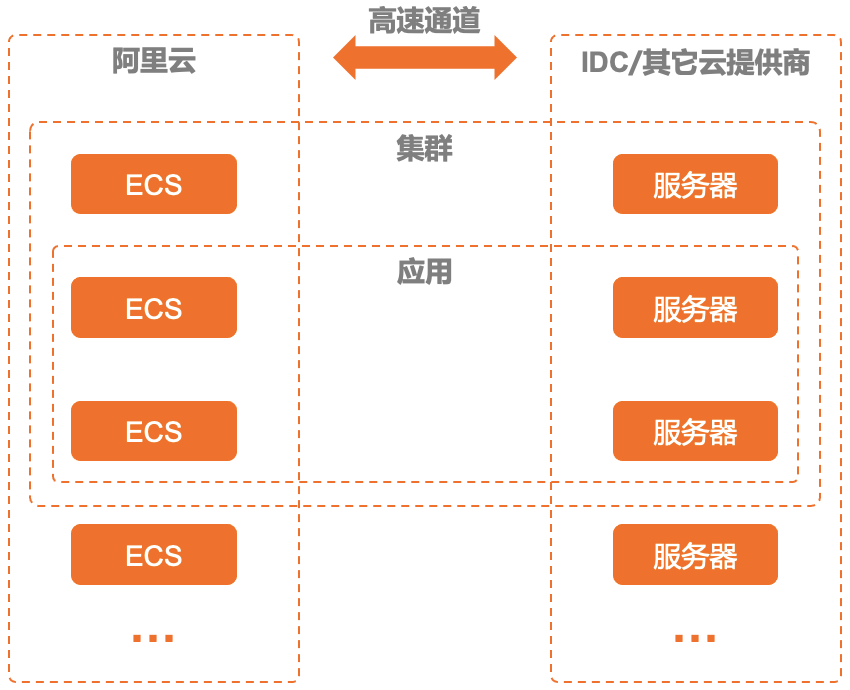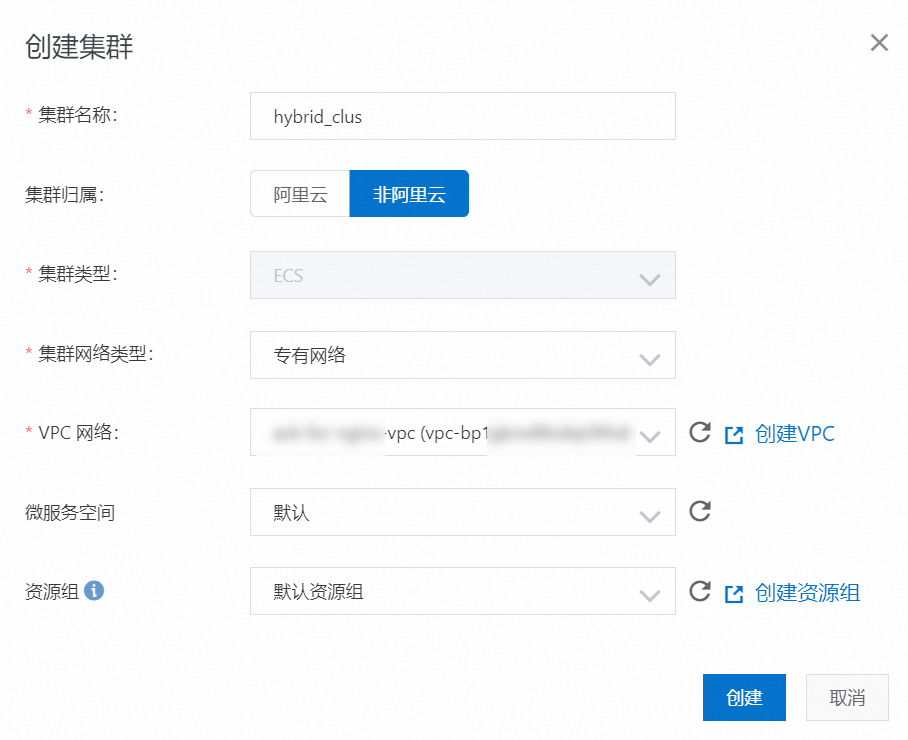EDAS支援混合雲ECS叢集,且可以對混合雲叢集的擴容、網路和統一管理等問題提供完整的解決方案。將阿里雲ECS、本地IDC或及其它雲端服務供應商的伺服器通過專線連通,並添加到EDAS混合雲ECS叢集中,即可將應用託管到混合雲ECS叢集,使用EDAS提供的一系列應用託管能力。
前提條件
背景資訊
您的應用系統可能同時有以下需求及問題:
雲端(阿里雲)流量有一定的波動性,尤其在某些時間段內會迎來流量高峰。流量可以預估,但難免有偏差,對於擴容的時間及ECS執行個體數量不好控制,且需要提前購買。
某些核心業務系統安全性要求較高,需要將這部分應用部署在自己的IDC(Internet Data Center,互連網資料中心) 內。這樣會面臨阿里雲、IDC及其它雲端服務供應商的伺服器間網路不通的問題,無法統一管理部署在不同環境下的應用。
根據實際的業務需求和可用性需求,希望將該應用系統同時部署在混合雲環境中。但將無法實現統一管控,需要人工處理,容易導致誤操作。
上述這些需求及問題都可以通過混合雲解決。
混合雲ECS的架構如下圖所示。

混合雲(非阿里雲)叢集包含阿里雲的ECS執行個體、IDC和其它雲供應商的伺服器。
阿里雲的ECS執行個體、IDC和其它雲供應商的伺服器通過Express Connect連通。
應用可以部署在混合雲ECS叢集中。
混合雲主要適用於以下情境:
阿里雲管理IDC:在您本地IDC通過專線接入阿里雲的VPC之後,您可以使用阿里雲EDAS管理IDC內的應用。
部署和管理其它雲端服務供應商的伺服器:使用EDAS,您能夠將應用部署到除阿里雲之外的雲端服務供應商的伺服器上,並進行統一管理。
本文檔主要介紹阿里雲管理IDC情境。部署和管理其它雲端服務供應商的伺服器只需要您將所需伺服器通過專線接入EDAS阿里雲的VPC,後續操作和公用雲管理IDC的情境一致。
準備工作
建立VPC。具體操作,請參見搭建IPv4專用網路。
申請建立和管理獨享專線串連,將您本地的IDC接入阿里雲VPC。
請確保本地IDC中的伺服器滿足如下要求:
作業系統:CentOS 7
物理機或虛擬機器(不支援Docker)
硬體:CPU和記憶體等無特殊要求
步驟一:建立混合雲叢集
登入EDAS控制台。
在左側導覽列選擇。
在EDAS ECS叢集頁面頂部功能表列選擇地區,在頁面上方選擇微服務空間,然後單擊建立叢集。
微服務空間可以在該頁面選擇,也可以在建立叢集對話方塊中選擇。
如果有環境隔離的需求,請選擇您建立的微服務空間。
如果沒有環境隔離的需求,可以選擇預設微服務空間。
在建立叢集對話方塊中設定叢集參數,然後單擊建立。

配置項
描述
叢集名稱
叢集名稱僅支援字母、數字、底線(_)和英文句號(.),且長度不能超過64個字元。
叢集歸屬
選擇非阿里云。
叢集類型
僅支援ECS,不可設定。
叢集網路類型
非阿里云ECS叢集的網路類型只能選擇專用網路。
VPC網路
選擇專用網路後,需要選擇建立的具體VPC。
微服務空間
叢集所屬的微服務空間。預設顯示為在EDAS ECS 集群頁面選擇的微服務空間。如果未選擇,列表中將顯示預設微服務空間。請根據實際需求選擇。
資源群組
叢集所屬的資源群組。該資源群組為當前帳號在阿里雲資源管理中建立的資源群組,而非EDAS的資源群組。如果沒有資源群組,可以單擊建立資源群組,跳轉到阿里雲資源管理主控台進行建立。具體操作,請參見建立資源群組。
叢集建立成功後會在當前頁面上方出現建立成功的提示,同時新建立的叢集會在叢集列表中顯示。
說明叢集建立成功後,僅僅是一個空叢集,需要添加阿里雲ECS執行個體和IDC中的伺服器。
步驟二:為混合雲叢集添加執行個體
您需要為剛剛建立的空的混合雲叢集添加阿里雲ECS執行個體、IDC和其它雲供應商的伺服器。
在叢集列表頁面單擊剛剛建立的叢集ID。
在叢集詳情頁面的ECS執行個體地區右上方單擊添加已有ECS。
在添加ECS執行個體對話方塊中複製EDAS Agent的安裝命令。
說明在混合雲叢集中僅支援通過命令列手動安裝EDAS Agent的方式添加執行個體。
使用root帳號登入您的阿里雲ECS執行個體或本地IDC中的伺服器,並複製、執行EDAS Agent安裝命令。
安裝命令執行後,該執行個體或伺服器就添加到叢集中了。
步驟三:開通所需連接埠
為保證您在混合雲中的應用能正常使用EDAS提供的相關能力,在添加執行個體後您需要為執行個體開通以下連接埠:
8182:用於抓取基礎監控、調用鏈監控日誌
12200~12300:用於完成RPC調用
65000~65535:Web連接埠
叢集中的執行個體類型不同,開通連接埠的方式也不同。
阿里雲ECS執行個體:開通連接埠的具體操作,請參見添加安全性群組規則。
IDC或其它雲供應商的伺服器:請參考對應方案開通相關連接埠。
結果驗證
- 返回EDAS ECS叢集頁面,在叢集列表中查看剛建立的叢集的叢集類型、叢集狀態和執行個體數。
- 叢集類型為ECS叢集(非阿里雲)、叢集狀態為正常,則說明叢集建立成功。
- 執行個體數和實際添加的執行個體數量一致,則說明執行個體添加成功。
- 單擊目的地組群的叢集ID,進入叢集詳情頁面。在ECS執行個體地區查看添加的執行個體名稱及健康检查狀態。 各執行個體的健康检查為運行中說明執行個體狀態正常。
後續步驟
混合雲ECS叢集建立成功後,即可在叢集中部署應用。部署應用的方式與在阿里雲ECS叢集的部署步驟一致,具體操作,請參見建立和部署應用概述。